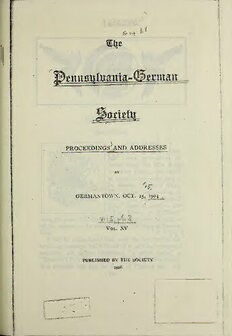
Proceedings and Addresses at Germanton, Pa., October 25, 1904 / The Pennsylvania-German in tlie French and Indian War. Frederick the Great and the United States,. Old Historic Germantown PDF
Preview Proceedings and Addresses at Germanton, Pa., October 25, 1904 / The Pennsylvania-German in tlie French and Indian War. Frederick the Great and the United States,. Old Historic Germantown
— o S \-\ m* r, emi0t|Djanxa-y^^rntaii PROCEEDINGS}AND ADDRESSES AT GERMAxNXOWN, OCT. 25, 1904 m—m 1 1X,V Vol. PUBLISHED BY THE SOCIETY 1906 LIS' f%&> 1^52382 CHAPTER XXIV. Fort Henry. Fort Henry. ?¥*& NE of the most promi- nent government de- fenses along the Blue Ridge was Fort Henry, also called, at times, in the early part of its history " Busse's Fort," after its first commanding of- ficer, " The Fort at Dietrich Six's," from its location, also " Fort Henry at Tolihaio," using the name " Tolihaio" in a general sense to apply to all the country in the vicinity of the Tolihaio, or Swatara Gap. It will be remembered that, with the first terrible out- break, or massacre, which found all in such an unprepared condition, the settlers established " a watch house " at " Dietrich's Six's Placeunder the Hill on Shamokin Road." It it probable this was the home of Dietrich Six. The (3i6) Fort Henry. 317 Fort Hcnpy a aoo o o a a oao I000 SITE, OF FORT HENRY. 3i8 The Pennsylvania-German Society, location was so excellent that the provincial government, upon taking charge of the defense, decided to build one of the larger forts on the spot. This property was on the old Shamokin (Sunbury) Road, three miles north of Millersburg, in Bethel Town- ship of Berks County. It was owned by Dietrich Six during the war and purchased from him by Frantz Um- benhauer, fromwhomitcame into the possession of George Pott, and was lately owned by James Batz. The fort stood in what is now a cultivated field, about twenty-five yards northeast from a shed, with stone base, standing by the roadside. It was on slightly elevated ground and commanded a splendid view of the approaches from the Blue Mountains, and of the valley to the west. At the foot of the elevated ground runs a little stream of water, originating at the spring back of the fort. Pieces of stone, belonging to the fort as well as pieces of common clay pipe stems and chips of flint are, even yet, occasionally ploughed up. In the distant past various Indian villages must have We been located in the neighborhood. are told the fort stood "under the hill on Shamokin Road." This hill, called " Round Top Mountain," rises abruptly from the plain about one mile east of the fort. So abruptly does it rise that it is almost impossible to scale the side facing the defense. Those who have attempted it. however, have found, about half-way up, an artificial plateau, about forty by one hundred and fifty feet, formed by taking out stones from the hill behind. These stones seem to have been broken to a small size, and were entirely different from the rock composing the remainder of the mountain, being much harder and making somewhat of a ringing sound when knocked together. The fact is interesting - Fort Henry. 319 because it is altogether probable that it was a quarry from which the aborigines obtained their arrow and axe heads, if not the flints for their muskets. Of the shape of the fort we know nothing definite. In our generation it has been, at best, but a heap of ruins, but we are assured from them that it was more pretentious in size than usual. The only description of any kind, which has been secured, was from a Mr. Daniel Hostetter, of Springsville, who, if now living, would be some seventy years old. Even this is of a rather vague character. He says most of the stone belonging to the fort was taken by the farmers for build- ing purposes, but, when he first saw it, the marks of the building were plain, and a portion of the wall remained. To him it seemed to be shaped like a half moon, and, in the center, was a house which evidently had a cellar under- neath. The walls of the fort were about three feet thick and some two hundred feet long. Mr. Hostetter adds that he "never saw such a place in his life and doubts if there be any other like it in the State." The first commanding officer of Fort Henry was Cap- tain Christian Busse, who, before the war, had been a doctor at Reading, Pa. Notwithstanding the terrible depredations committed by the Indians, the officers in command of the troops made every effort to prevent them, and their unceasing vigilance is well worthy of commendation. The following report of Colonel Weiser to Governor Morris, made in July, 1756, bears witness to this state- ment : "Honoured Sir: "Immediately after my Return from Philadelphia, I sent Orders to the Captains Busse, Morgan and Smith,
